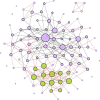Network model and analysis of the spread of Covid-19 with social distancing
- PMID: 33392389
- PMCID: PMC7770744
- DOI: 10.1007/s41109-020-00344-5
Network model and analysis of the spread of Covid-19 with social distancing
Abstract
The first mitigation response to the Covid-19 pandemic was to limit person-to-person interaction as much as possible. This was implemented by the temporary closing of many workplaces and people were required to follow social distancing. Networks are a great way to represent interactions among people and the temporary severing of these interactions. Here, we present a network model of human-human interactions that could be mediators of disease spread. The nodes of this network are individuals and different types of edges denote family cliques, workplace interactions, interactions arising from essential needs, and social interactions. Each individual can be in one of four states: susceptible, infected, immune, and dead. The network and the disease parameters are informed by the existing literature on Covid-19. Using this model, we simulate the spread of an infectious disease in the presence of various mitigation scenarios. For example, lockdown is implemented by deleting edges that denote non-essential interactions. We validate the simulation results with the real data by matching the basic and effective reproduction numbers during different phases of the spread. We also simulate different possibilities of the slow lifting of the lockdown by varying the transmission rate as facilities are slowly opened but people follow prevention measures like wearing masks etc. We make predictions on the probability and intensity of a second wave of infection in each of these scenarios.
Keywords: COVID-19; Epidemic spreading; Network science; Reproduction number; SIR model; Social network.
© The Author(s) 2020.
Conflict of interest statement
Competing interestsThe authors declare that they have no conflict of interest.
Figures










Similar articles
-
Determining the level of social distancing necessary to avoid future COVID-19 epidemic waves: a modelling study for North East London.Sci Rep. 2021 Mar 11;11(1):5806. doi: 10.1038/s41598-021-84907-1. Sci Rep. 2021. PMID: 33707546 Free PMC article.
-
Impact of self-imposed prevention measures and short-term government-imposed social distancing on mitigating and delaying a COVID-19 epidemic: A modelling study.PLoS Med. 2020 Jul 21;17(7):e1003166. doi: 10.1371/journal.pmed.1003166. eCollection 2020 Jul. PLoS Med. 2020. PMID: 32692736 Free PMC article.
-
Spatial network based model forecasting transmission and control of COVID-19.Physica A. 2021 Nov 1;581:126223. doi: 10.1016/j.physa.2021.126223. Epub 2021 Jul 1. Physica A. 2021. PMID: 34230756 Free PMC article.
-
Travel-related control measures to contain the COVID-19 pandemic: a rapid review.Cochrane Database Syst Rev. 2020 Oct 5;10:CD013717. doi: 10.1002/14651858.CD013717. Cochrane Database Syst Rev. 2020. Update in: Cochrane Database Syst Rev. 2021 Mar 25;3:CD013717. doi: 10.1002/14651858.CD013717.pub2. PMID: 33502002 Updated.
-
Optimal strategies for COVID-19 prevention from global evidence achieved through social distancing, stay at home, travel restriction and lockdown: a systematic review.Arch Public Health. 2021 Aug 21;79(1):150. doi: 10.1186/s13690-021-00663-8. Arch Public Health. 2021. PMID: 34419145 Free PMC article. Review.
Cited by
-
Strategies and Trends in COVID-19 Vaccination Delivery: What We Learn and What We May Use for the Future.Vaccines (Basel). 2023 Sep 16;11(9):1496. doi: 10.3390/vaccines11091496. Vaccines (Basel). 2023. PMID: 37766172 Free PMC article.
-
Prioritizing vaccination based on analysis of community networks.Appl Netw Sci. 2022;7(1):80. doi: 10.1007/s41109-022-00522-7. Epub 2022 Dec 2. Appl Netw Sci. 2022. PMID: 36505040 Free PMC article.
-
Occupations and their impact on the spreading of COVID-19 in urban communities.Sci Rep. 2022 Aug 18;12(1):14115. doi: 10.1038/s41598-022-18392-5. Sci Rep. 2022. PMID: 35982107 Free PMC article.
-
Mathematical modeling applied to epidemics: an overview.Sao Paulo J Math Sci. 2021;15(2):1025-1044. doi: 10.1007/s40863-021-00268-7. Epub 2021 Sep 30. Sao Paulo J Math Sci. 2021. PMID: 38624924 Free PMC article.
-
Socio-demographic and health factors drive the epidemic progression and should guide vaccination strategies for best COVID-19 containment.Results Phys. 2021 Jul;26:104433. doi: 10.1016/j.rinp.2021.104433. Epub 2021 Jun 8. Results Phys. 2021. PMID: 34123716 Free PMC article.
References
-
- Block P, et al. Social network-based distancing strategies to flatten the COVID-19 curve in a post-lockdown world. Nat Hum Behav. 2020;2020:1–9. - PubMed
-
- Chen Y-C et al (2020) A time-dependent SIR model for COVID-19 with undetectable infected persons. Preprint arXiv:2003.00122 - PMC - PubMed
LinkOut - more resources
Full Text Sources
